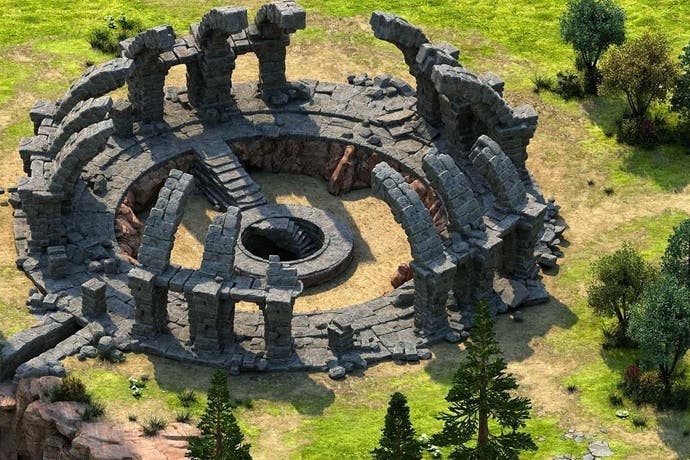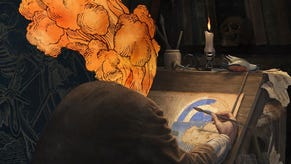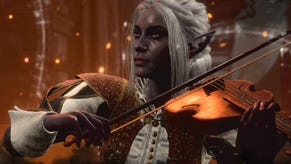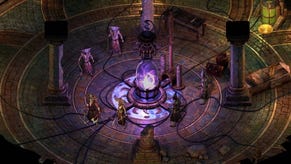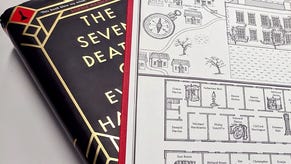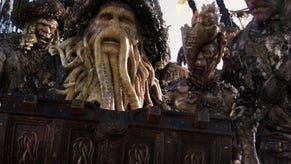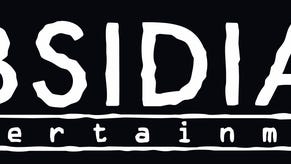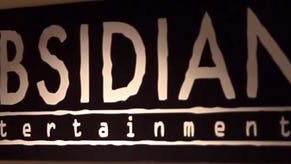The past lives forever in Pillars of Eternity
Hands on with the beta version of Obsidian's crowd-funded retro RPG.
Nostalgia is big business on Kickstarter, where PC gamers flocked to back projects that promised to roll the clock back to a time before egalitarian game design buffed the sharp edges off beloved hardcore genres. Enter Obsidian Entertainment, and Project Eternity, a crowd-funded role-player that proudly wears the C for computer in CRPG.
The game, now under its full title of Pillars of Eternity, raised almost $4 million back in 2012. If that feels like an age ago where Kickstarter stories are concerned, then Obsidian's aim is to look back even further, and party like it's 1998, a time when Infinity Engine powered games like Baldur's Gate, Planescape: Torment and Icewind Dale captivated a generation.
Based on the current backer's beta, it's definitely on course to realise that dream. Pillars of Eternity is retro in the best possible way. The heart is warmly familiar, with navigation, conversation and inventory systems that feel like old muscles being exercised for the first time in years. Creaky and a little stiff at times, but you can sense the power still stored in those dusty sinews.

The first thing you do is choose your difficulty setting. There's Easy and Normal, and a hard mode called Path of the Damned. On top of that are two additional toggles: Expert Mode removes the automated assists designed to ease novices in, while Trial of Iron is the extra hardcore option, restricting you to one save file and the threat of permadeath hanging over your character. On current form, that's going to be a real challenge, as Pillars of Eternity is seriously tough.
It's also very generous with character options, with a creation system that adds a few fun extra layers on top of the expected genre norms. You can opt to play as Human, Dwarf or Elf, of course, or you could play as an Aumaua, a tall, semi-aquatic, Avatar-esque creature, or a goblin-ish Orlan, smaller even than a dwarf, and apparently known for "mental intensity and quickness". Most fascinating are the Godlike, misshapen mutants with unusual abilities.
The Godlike also offer good examples of the game's strata of sub-races. Godlike offer four different variations - Death, Fire, Moon or Nature - each with their own distinct stat nudges. Similarly, every other race can be more closely defined by the region they come from: Hearth Orlan are former slaves, while Wild Orlan are a little more rugged. Aumaua vary in ability depending on whether they're from coastal regions or islands.
Particularly interesting is the way that races aren't constrained to their natural body types. If you want an Orlan with the build of a towering Aumaua, or a human-sized dwarf, you can. Even more distinctions can be built in with deep choices depending on your sub-race and build. Some have optional background cultures or elemental magic specialisms for some character builds, while others offer more tangible physical perks. I had one character build, a Nature Godlike, who got to be accompanied by a giant black bear.
The options keep piling up. There are 11 classes to choose from, though parsing the difference requires hands-on experience. The dividing line between a skilled Fighter and a brutish Barbarian is easy enough to grasp, but magic users will want to test drive the Wizard, Druid and Chanter classes before working out their relative strengths and weaknesses.
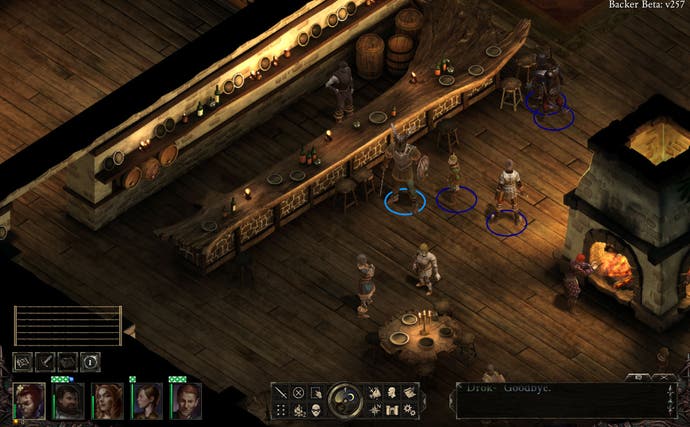
Compared to the box-ticking that passes for character creation in some modern RPGs, your gateway to Pillars of Eternity does a good job of teasing the potential depths of the full game. For now, the beta boosts you to Level 5 so you have a healthy stock of skill points to distribute, and drops you in with no introduction and a full party of four additional characters.
There's a relatively small slice of the world to explore, centred around the village of Dyrford. It's here that Eternity's visual charms are best illustrated. This is a very nice looking game, with finely detailed backgrounds that offer just enough ambient animation to be enchanting. From the rustic town square to the flickering fire-lit interior of the obligatory inn, it really makes the most of its top-down view to create a welcoming and engaging world.
The lore is rich, but organically introduced through conversation. The writing is good enough that you quickly pick up on the unique hopes and fears of the town - not least that their children are Hollowborn, the meaning of which you piece together but is quite clearly not a good thing - and there are also some more obvious quest givers to get you started. Guards from the royal House Harond are searching for a missing noblewoman, an ogre has been stealing a farmer's pigs and a mercenary called Medreth needs help in drawing out an alleged mass killer of children.
Each plot thread leads you to explore the regions neighbouring Dyrford, and it's here that you'll definitely encounter combat. The maps are small, and you're hemmed in by scenery that dictates your route through the area, so there's no real way to avoid the many aggressive creatures that are placed in your path.
Unfortunately, right now combat is the weakest feature. Since the beta fast-forwards you past five levels of skill accumulation, and offers no tutorial, there's a lot of trial and error as you work out the pros and cons of your abilities. It doesn't help that battles unfold quickly, and too readily turn into incomprehensible melee scrums where it's all but impossible to click on any one ally or enemy with consistent accuracy. I found that playing on Normal difficulty, I got instantly slaughtered by the first enemies I encountered - a group of beetles, for God's sake. Playing on Easy, encounters were almost the opposite, and almost entirely devoid of challenge or strategy. Even then, I found that I'd breeze through some fights only to get killed instantly in another without really understanding what I'd done differently.
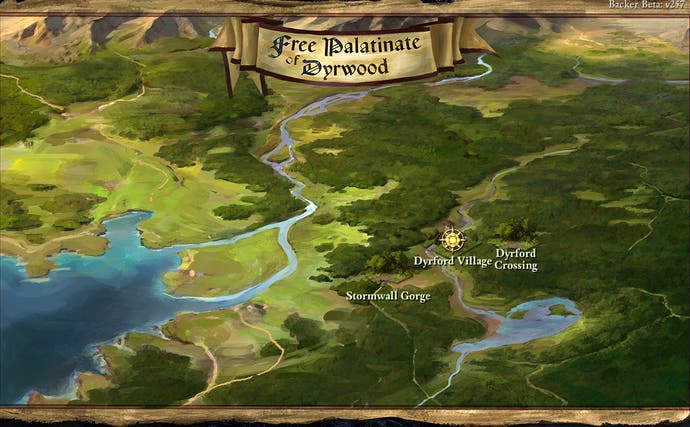
To help you make sense of the muddle, there are numerous auto-pause options, which will freeze the game whenever specific combat situations occur, and you can also slow things down with a prod of the S key. This at least helps you get your bearings, but doesn't address the jumble of overlapping characters you're expected to navigate in the thick of the action. It feels like a peculiar concession, as if the game is naturally leaning towards turn-based combat, but is afraid to commit fully for fear of annoying purist backers who cry foul at anything that doesn't fit their notion of what genre can offer.
Venture into the backer forum, and you discover another related debate burning up the threads. At the moment, the game offers no XP for victory in combat, only for completion of quests. It's an understandable decision when viewed in the context of the games Pillars of Eternity is trying not to be - "Go back to Skyrim" is a popular retort from those who see combat XP as an open door to grinding - but in a game that is clearly going to be very combat-centric, it does feel bizarrely punitive. The loot dropped by defeated enemies isn't exciting enough to compensate right now, and the thrill of victory in a tricky battle is undeniably dimmed when you realise you gained nothing of value from the encounter.
As always, the fact that this is a beta is a pretty good bulwark against criticism, even if its winter 2014 release window looms ever larger. Much can and will change over the coming months, and the combat balancing in particular is most definitely a work in progress.
What is clear is that those who backed Project Eternity on the promise of a thoroughbred RPG that embraces the classic D&D model, if not the actual license, aren't likely to be disappointed. Even at this early stage, and with only a few hours of gameplay to its name, Pillars of Eternity already feels generous, compelling and rich.
